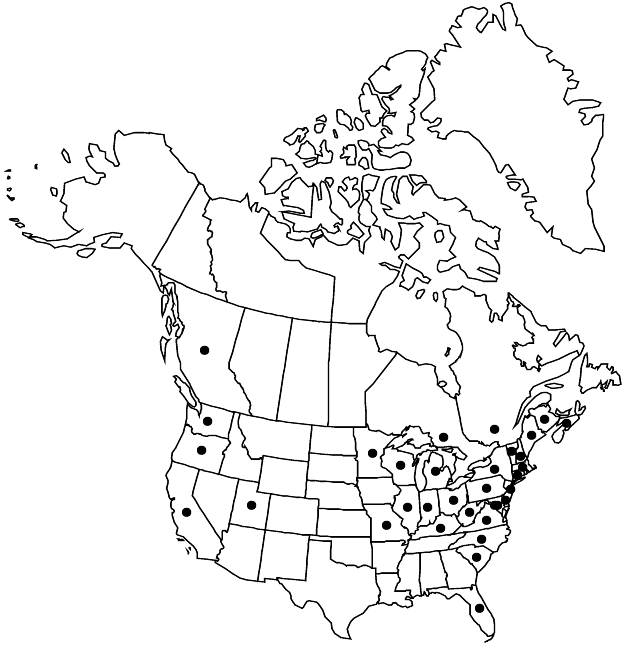Difference between revisions of "Silene armeria"
Sp. Pl. 1: 420. 1753.
FNA>Volume Importer |
imported>Volume Importer |
||
| (2 intermediate revisions by one other user not shown) | |||
| Line 8: | Line 8: | ||
}} | }} | ||
|common_names=Sweet-William catchfly;silène arméria | |common_names=Sweet-William catchfly;silène arméria | ||
| + | |special_status={{Treatment/ID/Special_status | ||
| + | |code=W | ||
| + | |label=Weedy | ||
| + | }}{{Treatment/ID/Special_status | ||
| + | |code=I | ||
| + | |label=Introduced | ||
| + | }} | ||
|basionyms= | |basionyms= | ||
|synonyms={{Treatment/ID/Synonym | |synonyms={{Treatment/ID/Synonym | ||
|name=Atocion armeria | |name=Atocion armeria | ||
|authority=(Linnaeus) Rafinesque | |authority=(Linnaeus) Rafinesque | ||
| + | |rank=species | ||
}} | }} | ||
|hierarchy=Caryophyllaceae;Caryophyllaceae subfam. Caryophylloideae;Silene;Silene armeria | |hierarchy=Caryophyllaceae;Caryophyllaceae subfam. Caryophylloideae;Silene;Silene armeria | ||
| Line 27: | Line 35: | ||
|elevation=0-1200 m | |elevation=0-1200 m | ||
|distribution=B.C.;N.B.;N.S.;Ont.;Que.;Calif.;Conn.;Del.;D.C.;Fla.;Ill.;Ind.;Ky.;Maine;Md.;Mass.;Mich.;Minn.;Mo.;N.H.;N.J.;N.Y.;N.C.;Ohio;Oreg.;Pa.;S.C.;Utah;Vt.;Va.;Wash.;W.Va.;Wis.;Europe. | |distribution=B.C.;N.B.;N.S.;Ont.;Que.;Calif.;Conn.;Del.;D.C.;Fla.;Ill.;Ind.;Ky.;Maine;Md.;Mass.;Mich.;Minn.;Mo.;N.H.;N.J.;N.Y.;N.C.;Ohio;Oreg.;Pa.;S.C.;Utah;Vt.;Va.;Wash.;W.Va.;Wis.;Europe. | ||
| + | |introduced=true | ||
|discussion=<p>The long-tubular, clavate calyx enclosing the unusually long carpophore helps to distinguish <i>Silene armeria</i>. It is an occasional and adventive garden escape.</p> | |discussion=<p>The long-tubular, clavate calyx enclosing the unusually long carpophore helps to distinguish <i>Silene armeria</i>. It is an occasional and adventive garden escape.</p> | ||
|tables= | |tables= | ||
| Line 36: | Line 45: | ||
-->{{#Taxon: | -->{{#Taxon: | ||
name=Silene armeria | name=Silene armeria | ||
| − | |||
|authority=Linnaeus | |authority=Linnaeus | ||
|rank=species | |rank=species | ||
| Line 51: | Line 59: | ||
|publication title=Sp. Pl. | |publication title=Sp. Pl. | ||
|publication year=1753 | |publication year=1753 | ||
| − | |special status= | + | |special status=Weedy;Introduced |
| − | |source xml=https:// | + | |source xml=https://bitbucket.org/aafc-mbb/fna-data-curation/src/2e0870ddd59836b60bcf96646a41e87ea5a5943a/coarse_grained_fna_xml/V5/V5_345.xml |
|subfamily=Caryophyllaceae subfam. Caryophylloideae | |subfamily=Caryophyllaceae subfam. Caryophylloideae | ||
|genus=Silene | |genus=Silene | ||
Latest revision as of 22:10, 5 November 2020
Plants annual, glabrous throughout, ± glaucous, sometimes glutnous in distal parts; taproot slender. Stems simple, branched in inflorescence, (10–)20–40(–70) cm. Leaves: basal withering before flowering, blade lanceolate-spatulate, 2–5 cm; cauline sessile to amplexicaulous, blade lanceolate to ovate or elliptic, 1–6 cm × 5–25 mm, apex acute. Inflorescences cymose, bracteate; cyme capitate or with flowers clustered at end of slender branches; bracts lanceolate-acicular, 2–10 mm. Pedicels 0.1–0.5 cm. Flowers: calyx usually purple tinged, 10-veined, elongate, clavate, lobed, constricted proximally into narrow tube, 13–17 × 2.5–4 mm, rather membranous; lobes ovate-triangular, ca. 1 mm, apex obtuse; petals pink (rarely white), unlobed, limb obovate, ca. 5 mm, base cuneate into claw 6–8 mm, auricles absent, appendages linear to lanceolate, 2–3 mm, apex acute; stamens slightly longer than petal claws; styles 3(–4), exserted. Capsules oblong, 7–10 mm, opening by 6 (or 8) spreading teeth; carpophore 7–8 mm, glabrous. Seeds dark brown, reniform-rotund, less than 1 mm diam., rugose. 2n = 24 (Europe).
Phenology: Flowering summer.
Habitat: Waste places, disturbed ground
Elevation: 0-1200 m
Distribution

Introduced; B.C., N.B., N.S., Ont., Que., Calif., Conn., Del., D.C., Fla., Ill., Ind., Ky., Maine, Md., Mass., Mich., Minn., Mo., N.H., N.J., N.Y., N.C., Ohio, Oreg., Pa., S.C., Utah, Vt., Va., Wash., W.Va., Wis., Europe.
Discussion
The long-tubular, clavate calyx enclosing the unusually long carpophore helps to distinguish Silene armeria. It is an occasional and adventive garden escape.
Selected References
None.